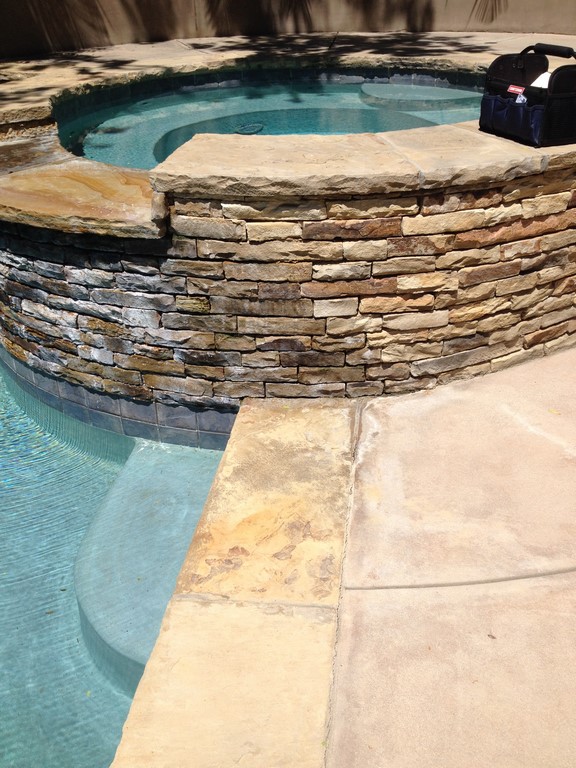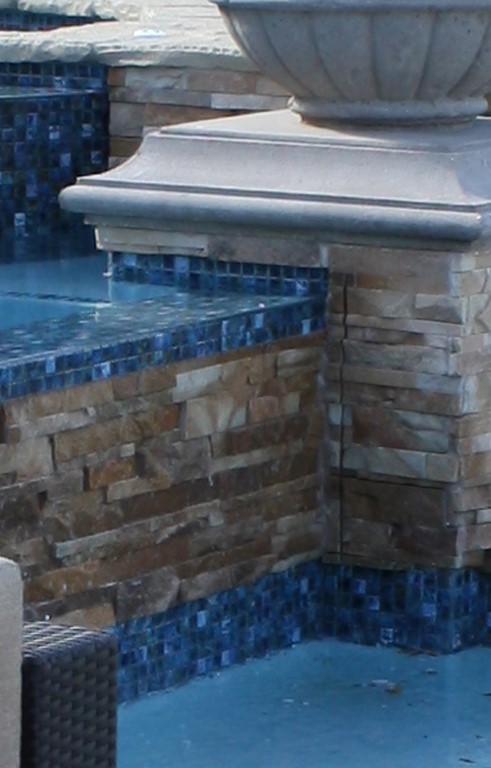Water on the Move

In my work as a construction-defect expert witness, I see a certain problem in the design and construction of spillways all too frequently: When the system is initiated, the flow of water down the face of the dam wall will behave more or less as desired, holding to a narrow path into the pool or trough that awaits it. After a time, however, that water will begin to migrate, spreading out farther and farther beyond the desired pathway until the material – usually some sort of brick or stone – builds up scale and starts looking awful as the situation advances.
This time, I’ll report on a situation in which the consequences of the water migration were basically aesthetic. Next time, I’ll look at a case in which the water traveled in such a way that it actually did significant damage.
The scenario: A project I was asked to investigate had a classic water-migration issue: The water was set up to spill from one level to another in such a way that it flowed down the face of the wall instead of pushing past the wall’s surface via some sort of extension that would let it drop directly into the pool without hugging the wall. (This can be particularly problematic with stacked stone, which creates easy horizontal planes along which the water can flow.)
| Water migration made a mess of areas on both sides of this spillway, with the horizontal ledger detail giving the water numerous paths away from the desired drop zone. As seen on the left, the water flowed onto a step and then down onto the deck, staining the surfaces and seriously compromising the look. (Note that it also traveled about five feet along the coping/grab rail.) The same sort of ugliness is seen on the right. |
When the water first started flowing in this spillway, it rolled down the face of the ledgerstone dam wall and more or less directly into the pool. Almost immediately, however, it began broadening its path to include adjacent sections of wall – and finally a step that started looking awful in rapid order.
The fix: Clearly, what happened here was that the stone’s surface had little or no ability to serve as a limiting vertical channel for the water. Water being water, in other words, it found other paths by trickling sideways and wicking onto surrounding surfaces.
Getting rid of this problem, unfortunately, requires anticipating it by including a vertical break in the finish that will encourage the great majority of the water to flow in the desired downward direction.
| One solution to the water-migration problem involves leaving or cutting s vertical channel in the stonework, giving the water a natural place to drop vertically rather than migrating horizontally. Yes, it’s a visual break, but it’s a small aesthetic sacrifice compared to the nightmares seen above. |
In the project shown in the photograph at left, for example, a vertical break was planned and built right into the wall system. It doesn’t need to be big to be effective: A half inch gap or less will do the job of directing the majority of the migratory flow directly down into the pool or trough. And to be on the safe side, treating the gap with a silicone sealant will keep the far side of the channel from becoming an eventual pathway (however minor) for traveling water.
To be sure, this solution has aesthetic consequences and might provide an unwelcome visual break in some situations, but it will eliminate most of the worsening appearance presented by water migration. In fact, this might even be an essential, unavoidable step with horizontally oriented finish materials, such as ledgerstone or brick.
And don’t overlook the possibility of designing such spillways with a protruding edge that directs the water out past the wall. The flow rate must be fairly robust, and some water will find its way to the wall, but this may be the best way to reduce migrating-water issues.
Lesson Learned: Water seldom follows only those paths you want it to follow, and the key to avoiding the problems it presents when it migrates is to accept the immediate challenge and give it an easier way to flow where you want it to go, either by using a baffle or vertical break – or focusing on a better spillway design.
Scott Cohen is a construction defect expert witness and president of The Green Scene, an outdoor design/construction firm in Chatsworth, Calif. Past articles in the Lessons Learned series have been compiled in his book, The Candid Contractor. He also provides consultation for clients nationwide and gives seminars on designing landscapes, swimming pools and outdoor kitchens. For more information, go to www.greenscenelandscape.com.













